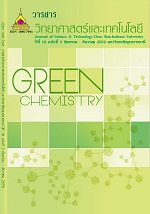ปฏิกิริยาคลอริเนชันของสารอนุพันธ์ 4,6-ไดเมทอกซีอินโดล
Main Article Content
บทคัดย่อ
Chlorination of 4,6-Dimethoxyindole Derivatives
This research studied the chlorination of 4,6-dimethoxyindole derivatives with N-chlorosuccinimide in dichloromethane. The chlorination of 7-formyl-4,6-dimethoxy-2,3-diphenylindole without substituents at C5 gave 5-chloroindole which was substituted with chlorine atom at C5. The chlorination of 4,6-dimethoxy-2,3-diphenylindole without substituents at C5 and C7 and 3-(4-bromophenyl)-7-formyl-4,6-dimethoxyindole without substituents at C2 and C5 gave 7-chloro and 2-chloroindoles as selective products respectively. In the case of the chlorination of 3-(4-bromophenyl)-4,6-dimethoxyindole without substituents at C2, C5 and C7 gave only 7-chloroindole product. Moreover, the chlorination of 4,6-dimethoxyindole without substituents at C2, C3, C5, and C7 gave selective 3-chloroindole product. These results illustrated that the reactivity series of chlorination of 4,6-dimethoxyindole derivatives with N-chlorosuccinimide is C3, C7, C2, and C5 respectively. Finally, the results on the regio-selectivities of chlorination products were similar to bromination products but the chemical yield of chlorination products were more than those of bromination products.
Article Details
บทความที่ได้รับการตีพิมพ์เป็นลิขสิทธิ์ของ วารสารวิทยาศาสตร์และเทคโนโลยี มหาวิทยาลัยอุบลราชธานี
ข้อความที่ปรากฏในบทความแต่ละเรื่องในวารสารวิชาการเล่มนี้เป็นความคิดเห็นส่วนตัวของผู้เขียนแต่ละท่านไม่เกี่ยวข้องกับมหาวิทยาลัยอุบลราชธานี และคณาจารย์ท่านอื่นๆในมหาวิทยาลัยฯ แต่อย่างใด ความรับผิดชอบองค์ประกอบทั้งหมดของบทความแต่ละเรื่องเป็นของผู้เขียนแต่ละท่าน หากมีความผิดพลาดใดๆ ผู้เขียนแต่ละท่านจะรับผิดชอบบทความของตนเองแต่ผู้เดียว


